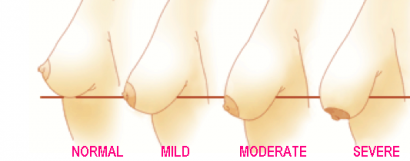Sagging breasts – also known as Breast ptosis or saggy breast syndrome – are a natural and inevitable part of the aging process. But that doesn’t make it any less distressing or uncomfortable for you. Many women equate their femininity and youth with the size, shape and look of their breasts. Some patients report that their sagging, drooping breasts make them feel unattractive and old.
Are your nipples pointing south? Do you hate the look of your sagging, droopy breasts? You are not alone. Many women across Australia suffer from ptosis of the breast. As we age, our skin loses elasticity, causing gravity to drag our breasts down. Other factors such as smoking, significant weight loss and pregnancy can stretch and thin the skin past the point of it “bouncing back”. So today we are going to answer your much asked question – what to do if my boobs are saggy!
But Why Are My Boobs Saggy?
Involution is one of the most common causes for sagging breasts. This is the process where the milk-making system inside the breast shrinks because it is no longer required. Involution tends to occur after weaning or, in non-breastfeeding women, not long after pregnancy. Involution also tends to occur during menopause – but it isn’t uncommon for it to happen at younger ages!
The shrinking of the milk-making system in the breast makes your breasts appear saggy and empty. This is due to the fact that breasts do not have muscles in them. Instead they are made up of tissue and ligaments. As we age, gravity pulls down on our breasts, stretching the tissues and ligaments. If you have good genes, nutritional intake and environment, then your level of drooping may be less pronounced than others with less elasticity in their breast skin and ligaments.
Further, larger breasts have a greater tendency to sag and droop because there is more weight in them for gravity to act upon. But smaller will also begin to sag and droop if empty of tissue. Exercise, such as running and tennis, can also cause ligaments inside your breasts to stretch or tear. As the breast droops, so does the nipple which can begin to point downward or even fall below the fold of the breast.
Finally, weight loss can also cause your breasts to droop and sag. This is due to the fact that breasts have a high volume of fat to tissue. Tissue can atrophy with age and weight change. This means that losing weight means losing fat and volume in your breasts. This results in empty, droopy looking breasts. Unlike other areas of our body, the skin and ligaments in the breasts do not always react according to your weight loss and might not shrink.
Ptosis of the Breast
Aging breast glandular tissue results in breast laxity, meaning that as you age your breasts may feel or look “empty” as the glandular tissue inside them reduces. Your breasts are made of tissues including heavy glandular tissue – that helps produces milk – and fat. Some women have a larger ratio of tissue in their breasts meaning theirs are heavier. Heavier breasts will tend to sag faster and further over time. Others feel their breasts have been left empty after breastfeeding as the amount of breast tissue reduces.
There are different levels – or grades – of ptosis. The first grade is known as mild-shape malformation. The second grade is known as moderate ptosis and many women at this level have difficulty with bra support and active sports, like running. Grade three ptosis usually results from significant size change, most likely due to pregnancy or serious weight loss. Grade four is known as Allotrophic skin as the breasts have poor collagen strength.

What Can I Do If My Boobs are Saggy?
There are some ways to help prevent premature sagging and drooping of your breasts. Always ensure that you wear protection during high impact sports. It is fundamental that you wear a supportive bra, daily, to help prevent premature drooping, especially for those with larger breasts. Avoiding smoking and a diet high in Vitamin C is also beneficial.
If your breasts have already begun to droop and you want to correct it, you might want to investigate a breast lift with, or without, implants.
Can I Get a Breast Lift if My Boobs are Saggy?
A breast lift without implants repositions the breasts into a higher position on the chest. The result is similar to the look of wearing a bra, without one. The breasts look better and are returned to their original position. The downside is, naturally, scar
ring and that you will not increase fullness, firmness or size.
A breast lift with implants is similar to a breast lift, but also involves improving the fullness, firmness and size of the breast. The downside is, again, scarring. You may also need to replace your breast implants, with some women needing replacements every 10 years or so.
To find out more, visit our Breast Lift page.
Can a Breast Augmentation Help if My Boobs are Saggy?
Breast augmentation involves the insertion of an implant without a lift. It increases the size, fullness and firmness of the breast, especially those that feel their breasts have become “emptier” after pregnancy or aging. Breast augmentation is mostly used in cases where there is not enough tissue but the skin is not too loose.
To find out more please visit our Breast Augmentation page.
How Do I Know Which Procedure is Best for Me?
It is best to discuss your situation with a professional plastic surgeon like Dr. Drielsma. However, there are some tests you can try at home. Breast augmentation is not right for you if you can fit two fingers behind the breast that the crease (also known as the inframammary fold). If you can place a pencil under your breast, in this fold, and it does not fall, you will also need a lift along with your augmentation.
Don’t have a pencil or pen to test with? Try putting your hands on your head. If your breasts still sag, you will need a lift. Look at the position of your nipple. If it falls below the fold and/or points to the ground, you will need a lift as well as augmentation and possible nipple placement surgery.
What About Scars and Post-Op?
Any surgery will leave a scar and it is important to understand your potential level of scarring by discussing it in depth with your surgeon.
Breast lifting has undergone considerable refinement over the years with reduction of scars and improvement of shape. Dr Drielsma was one of the first surgeons in Australia to introduce the “lollipop” minimal scar technique. This method gives a superior natural look with minimal possible scarring.
it is important to follow all your post-operative instructions to help improve your scar results as well as aid your healing. If you feel good, you will natural heal better. Scars will fade with time, and it will take your breasts about 12-18 months to fully settle into their final position.
Whichever version of breast surgery you’d like to pursue, breast lifts can be life changing. Reclaim your confidence and femininity with a look, feel and silhouette you will love. Click here if you would like more information on our breast lift surgery or breast lift surgery with implants, or contact us today to book a consultation with Dr. Drielsma to discuss your options.

